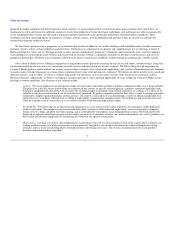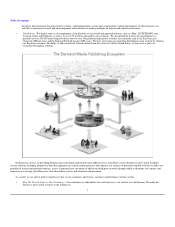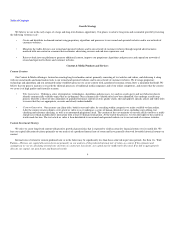Enom 2010 Annual Report Download - page 18
Download and view the complete annual report
Please find page 18 of the 2010 Enom annual report below. You can navigate through the pages in the report by either clicking on the pages listed below, or by using the keyword search tool below to find specific information within the annual report.
Table of Contents
If we are unable to continue to drive and increase visitors to our owned and operated websites and to our customer websites and convert these visitors into
repeat users and customers cost-effectively, our business, financial condition and results of operations could be adversely affected.
The primary method that we use to attract traffic to our owned and operated websites and to our customer websites and convert these visitors into repeat
users and customers is the content created by our freelance content creators. How successful we are in these efforts depends, in part, upon our continued
ability to create and distribute high-quality, commercially valuable content in a cost effective manner at scale that connects consumers with content that meets
their specific interests and enables them to share and interact with the content and supporting communities. We may not be able to create content in a cost
effective manner or that meets rapidly changing consumer demand in a timely manner, if at all. Any such failure to do so could adversely affect user and
customer experiences and reduce traffic driven to our owned and operated websites and to our customer websites through which we distribute our content,
which would adversely affect our business, revenue, financial condition and results of operations.
One effort we employ to create and distribute our content in a cost effective manner is our proprietary technology and algorithms which are designed to
predict consumer demand and return on investment. Our proprietary technology and algorithms have a limited history, and as a result the ultimate returns on
our investment in content creation are difficult to predict, and may not be sustained in future periods at the same level as in past periods. Furthermore, our
proprietary technology and algorithms are dependent on analyzing existing Internet search traffic data, and our analysis may be impaired by changes in
Internet traffic or search engines' methodologies which we do not have any control over. The failure of our proprietary technology and algorithms to
accurately identify content that generates traffic on websites through which we distribute our content and which creates a sufficient return on investment for
us and our customer websites would have an adverse impact on our business, revenue, financial condition and results of operations.
Another method we employ to attract and acquire new, and retain existing, users and customers is commonly referred to as search engine optimization,
or SEO. SEO involves developing websites to rank well in search engine results. Our ability to successfully manage SEO efforts across our owned and
operated websites and our customer websites is dependent on the timely modification of SEO efforts from time to time in response to periodic changes in
search engine algorithms, search query trends and related efforts by providers of search services designed to ensure the display of unique offerings in search
results. Our failure to successfully manage our SEO strategy could result in a substantial decrease in traffic to our owned and operated websites and to our
customer websites through which we distribute our content, which would result in substantial decreases in conversion rates and repeat business, as well as
increased costs if we were to replace free traffic with paid traffic. Any or all of these results would adversely affect our business, revenue, financial condition
and results of operations.
Even if we succeed in driving traffic to our owned and operated websites and to our customer websites, neither we nor our advertisers and customers
may be able to monetize this traffic or otherwise retain consumers. Our failure to do so could result in decreases in customers and related advertising revenue,
which would have an adverse effect on our business, revenue, financial condition and results of operations.
If Internet search engines' methodologies are modified, traffic to our owned and operated websites and to our customers' websites and corresponding
consumer origination volumes could decline.
We depend in part on various Internet search engines, such as Google, Bing, Yahoo!, and other search engines to direct a significant amount of traffic to
our owned and operated websites. For the quarter ended December 31, 2010, approximately 43% of the page view traffic directed to our owned and operated
websites came directly from these Internet search engines (and a majority of the traffic
16
























